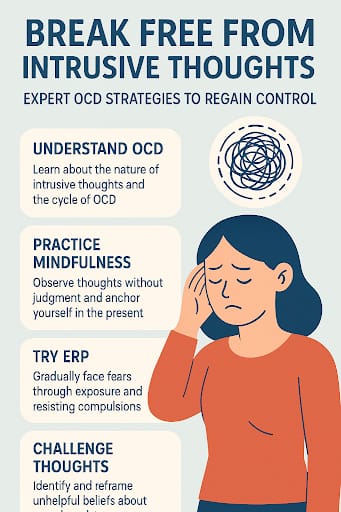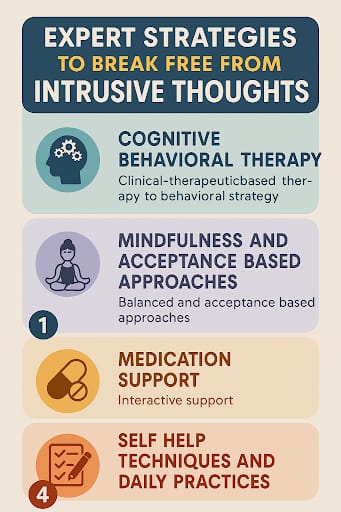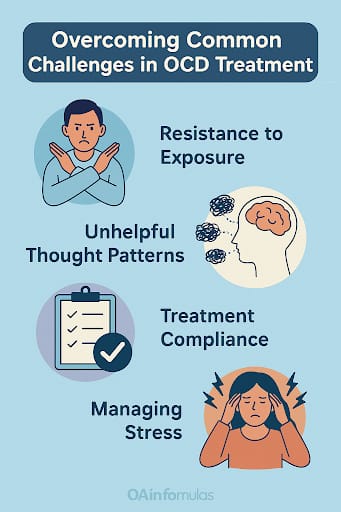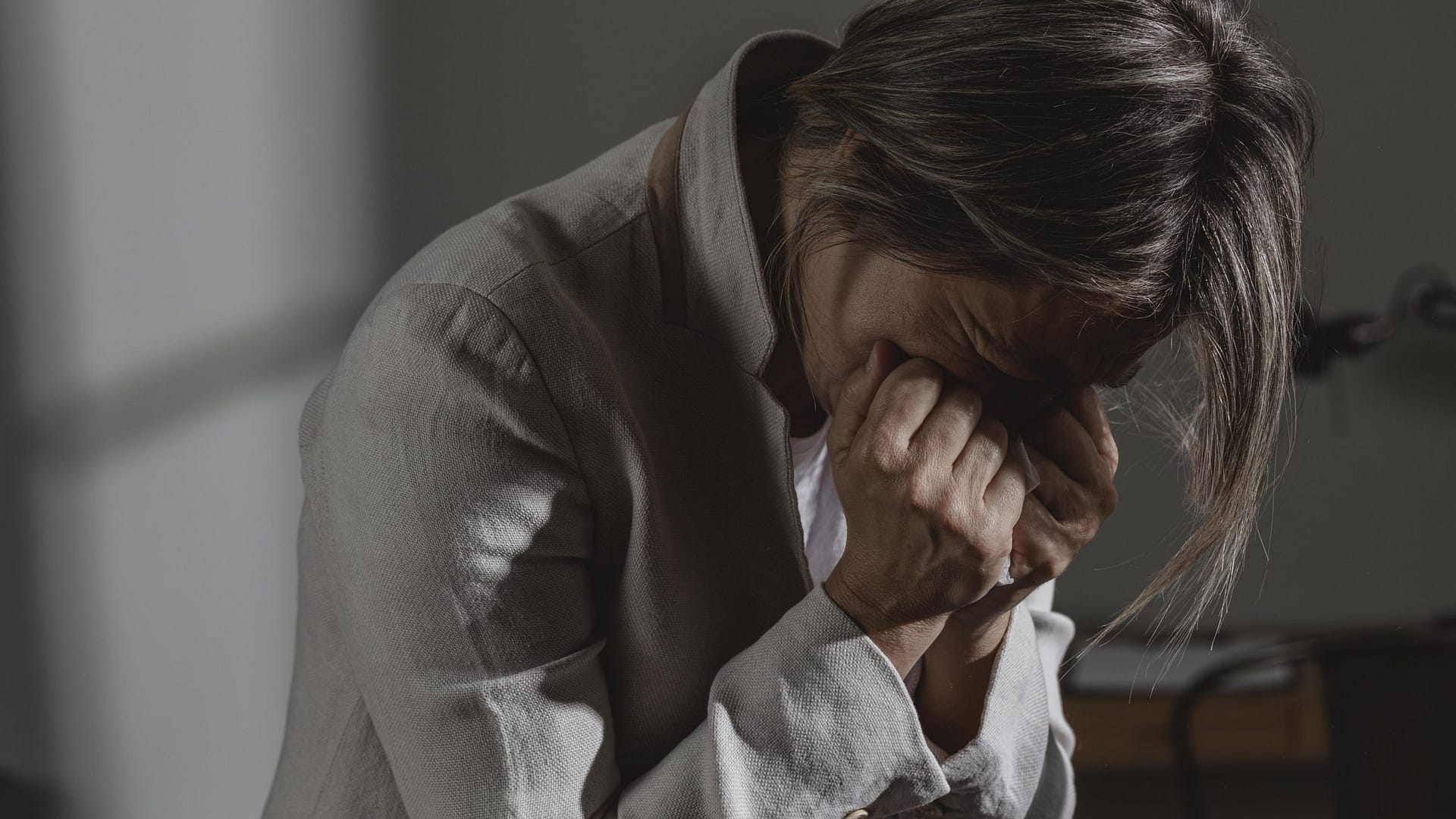
INTRODUCTION
Intrusive thoughts might seem crushing, unstoppable, and profoundly uncomfortable to manage— especially to someone who is navigating OCD. These unwanted, repetitive thoughts can cause disruption in your daily life by resulting in an unending cycle of anxiety and unease—one that may seem inescapable.
The good news is that you can break free from these thoughts. With deliberate strategies taken from evidence-based therapies, as well as mindfulness techniques, you can regain control over your mind and lessen the influence of intrusive thoughts.
This blog will talk about practical ways that you can break free from intrusive thoughts so you can reclaim your reasoning and live more freely each day!
What Are Intrusive Thoughts?
Intrusive thoughts are involuntary, uninvited thoughts or images that pop into one’s mind often unexpectedly and cause distress. Intrusive thoughts can be violent, sexual, unacceptable in nature, and everyone has that at one point or another.
When enduring obsessive-compulsive disorder (OCD), thoughts are hard to ignore and can persist where these thoughts can elicit anxiety, guilt, and shame. Intrusive thoughts can lead to compulsions and/or mental rituals if they create anxiety.
An example can be an intrusive thought about harming a loved one when someone has no intention of harming them but the thought is distressing. To manage this distress, they might check that knives are safely locked away repetitively or say a comforting phrase repeatedly in their mind to reassure themselves.
Why Do Intrusive Thoughts Happen in OCD?
Intrusive thoughts happen as a result of how the brain processes uncertainty, perceived threat, and the need for control.
- A person with OCD has a brain that is hardwired to overvalue the risk from particular thoughts, and to misinterpret these naturally occurring mental events as threats against their person.
- This misunderstanding leads to an exaggerated emotional response and a profound fear of whatever the thought or image is.
- The individual with OCD then hyper-focuses on the thought, attaching an exaggerated sense of meaning to having the thought (e.g., “because I had this disturbing thought, I must be dangerous or immoral”).
- If we add in a cognitive distortion called thought-action fusion, which is a belief that thinking about a negative event makes it more likely to happen, we can better understand the cycle of intrusive thoughts and compulsions.
- Compulsions are actions performed in an attempt to decrease the anxiety caused by the intrusive thought, and provide immediate but temporary relief, ultimately strengthening the cycle and making the intrusive thoughts occur more frequently.
- Compulsions for individuals with OCD who can’t tolerate uncertainty about the future are even more difficult to desist because intrusive thoughts run counter to certain features of their need to control and assure themselves.
Expert Strategies to Break Free from Intrusive Thoughts

1. Cognitive Behavioral Therapy
Cognitive Behavioral Therapy (CBT) and a specific type of CBT called Exposure and Response Prevention (ERP), is considered the gold standard treatment for OCD. ERP involves confronting fears (thoughts or situations) while resisting the urge to engage in compulsive behaviors that typically bring relief from anxiety.
After practicing this repeatedly, the brain learns that intrusive thoughts aren’t too debilitating and don’t require a response. For example, the person afraid of contamination might go from touching a doorknob, to not washing their hands immediately after (letting the anxiety decrease itself).
2. Mindfulness and Acceptance Based Approaches
Mindfulness and acceptance-based approaches help individuals to observe intrusive thoughts and refrain from judging or acting on them. Instead of pushing away or fighting with intrusive thoughts, mindfulness approach suggests noticing intrusive thoughts, sitting with the thought, and allowing it to pass naturally.
With a change in perspective the emotional content of the thought is diminished, and the compulsive loop typically found in OCD is disengaged. These approaches focus on using techniques such as breathing, focusing attention by the use of meditation or grounding techniques, so that attention is brought back to what is actually happening at that moment.
These approaches promote a long-term way of building emotional resilience and lessens the hold intrusive thoughts have.
3. Medication Support
For managing the symptoms of OCD, especially intrusive thoughts, medications can be effective. Selective Serotonin Reuptake Inhibitors (SSRIs) are commonly prescribed as a first-line treatment to reduce obsessive-compulsive symptoms and, in fact, help with daily functioning.
Sometimes, they can be combined with other medications (known as cognitive enhancers or augmentation agents) to improve the efficacy of therapy. The role of medication is to change the way brain chemistry is regulated and to help maintain emotional balance.
Obviously medication cannot promise complete symptom relief; however, again, medication combined with psychotherapy, especially Cognitive Behavioral Therapy (CBT) or Exposure and Response Prevention (ERP), is often the best alternative for longer-term surge in symptom management.
4. Self Help Techniques and Daily Practices
Using self help strategies and incorporating daily practices can act as adjuncts to the management of OCD symptoms, in particular intrusive thoughts.
- Writing in a journal allows individuals to record their thoughts, feelings and emotional reactions, in addition to creating psychological distance and reducing the intensity of intrusive thoughts.
- Setting aside a specific time each day to “worry”, when intrusive thoughts are supposed to intrude, helps people recognize their intrusive thoughts and manage them according to the framework of the worry schedule, which in the long run, acts to minimize their intrusions at random times and minimizes their impact over time.
- Incorporating regular exercise will help reduce the level of stress hormones in the body and also assist in activating mood enhancers, which will decrease overall anxiety rates.
- Overall stress reduction through sleep hygiene will also be important for improving emotional resilience through better sleep which should support mental clarity throughout the day.
Overcoming Common Challenges in OCD Treatment

It takes patience, support and a realistic mindset to work through the common hurdles in OCD treatment.
Fear of exposure is an important hurdle, which may inhibit a person from engaging in Exposure Response Prevention (ERP) therapy. It may feel terrifying to face intrusive thoughts; however, avoidance only serves to strengthen the OCD cycle. If one is provided with step-by-step supported exposure the brain can be retrained to identify a feeling of safety.
Relapse and setbacks can occur frequently, as OCD is a chronic disorder and it is important to keep that in mind. The goal is lifelong management as opposed to lifelong perfection.
Feelings of shame and stigma can make it difficult to talk about intrusive thoughts. Understanding that OCD is a brain disorder helps reduce feelings of self-blame and it allows one to reach out for support.
How to Get Started on Your Recovery Journey
The first step in your recovery process is realizing and internalizing what these intrusive thoughts are—they are just thoughts, not reality or actual threats.
- Knowing this is the first initial step toward taking your control back. It’s important to find a professional to help you with this process; a trained licensed therapist with experience treating OCD and ERP will be able to give you appropriate personalized tools for your healing.
- Additionally, you should create a dependable support system along the way; family, friends and support groups can provide emotional support and help you feel less isolated.
- Lastly, take your time in your recovery, and be kind to yourself. Recovery takes time and it is important to recognize all the little steps you take forward along the way! Don’t view setbacks as failures, but rather view them as opportunities for personal growth.
Final Thought
It is completely possible to break free from intrusive thoughts, when you have correct strategies and support.
- By involving therapies such as CBT and ERP, practicing mindfulness, using medication if and when needed, and employing self-help methods, you can take back control over your thoughts and diminish the ability of the thoughts to dictate your mindset.
- OCD does not define who you are, and with time, patience, and compassion toward yourself in the process, you can begin to heal.
- Asking for help is not weak; it is being courageous and practicing self-care. You are entitled to peace of mind and the ability to live fully and authentically.
Reference
- Wiginton, K. (2024, April 23). What are intrusive thoughts? WebMD. https://www.webmd.com/mental-health/intrusive-thoughts
- Obsessive-Compulsive disorder: when unwanted thoughts or repetitive behaviors take over. (n.d.). National Institute of Mental Health (NIMH). https://www.nimh.nih.gov/health/publications/obsessive-compulsive-disorder-when-unwanted-thoughts-or-repetitive-behaviors-take-over
- Foa, E. B. (2010). Cognitive behavioral therapy of obsessive-compulsive disorder. Dialogues in Clinical Neuroscience, 12(2), 199. https://doi.org/10.31887/DCNS.2010.12.2/efoa
- Bürkle, J. J., Schmidt, S., & Fendel, J. C. (2025). Mindfulness- and acceptance-based programmes for obsessive-compulsive disorder: A systematic review and meta-analysis. Journal of Anxiety Disorders, 110, 102977. https://doi.org/10.1016/j.janxdis.2025.102977
- International OCD Foundation. (2023, December 13). International OCD Foundation | Medications for OCD. https://iocdf.org/about-ocd/treatment/meds/
- Treatment challenges – beyond OCD. (n.d.). https://beyondocd.org/information-for-individuals/treatment-challenges
- Obsessive-compulsive disorder (OCD) – Diagnosis and treatment – Mayo Clinic. (n.d.). https://www.mayoclinic.org/diseases-conditions/obsessive-compulsive-disorder/diagnosis-treatment/drc-20354438






